2. 中国地质大学(北京) 能源学院, 北京 100083;
3. 北京大学地球与空间科学学院, 北京 100871
2. College of Energy Resources, China University of Geosciences, Beijing 100083, China;
3. School of Earth and Space Science, Peking University, Beijing 100871, China
2013年4月20日在龙门山南段的雅安市芦山县附近发生了一次MW6.7地震(图 1).这是继2008年5·12汶川MW7.9大地震后,在龙门山地区发生的又一次破坏性强震.汶川地震发生在龙门山中段,产生了两条同震地表破裂带(徐锡伟等,2008;李海兵等,2008;李勇等,2008;马寅生等,2008).芦山地震发生在龙门山南段,但是震后野外科考调查结果表明,发震断层并未突破地表产生同震破裂(李传友等,2013;雷生学等,2014),因此研究分析可能为一前缘隐伏断层或盲断层(徐锡伟等,2013;Liu et al,2015).有研究依据龙门山南段主要断裂分布,推测可能为山前大邑隐伏断裂(F6)(李勇等,2013;周荣军等,2013).此外,前人对芦山地区人工地震反射剖面的解释结果,认为芦山地震的发震断层为前缘隐伏逆断层(Range Front Blind Thrust),倾角较缓大约在30°左右(Li et al., 2014a;Wang et al., 2014).
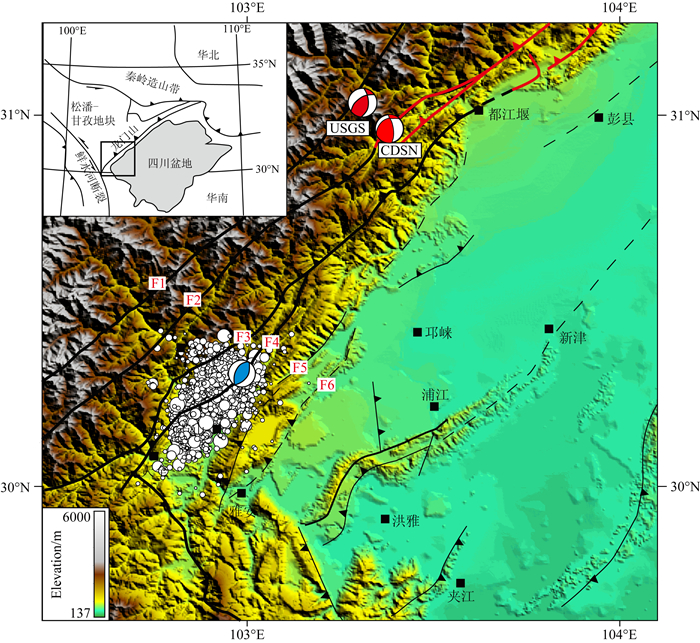
|
图 1 龙门山冲断带南段芦山震区区域构造简图 图中黑色实线为主要断裂分布,虚线为隐伏断裂,红色实线为汶川地震同震地表破裂带;F1:陇东断裂;F2:五龙断裂;F3:小关子断裂;F4:双石—大川断裂;F5:新开店断裂;F6:大邑隐伏断裂. Fig. 1 Map showing tectonics of the Lushan earthquake area in the southern Longmen Shan thrust zone Black solid lines are major faults. Dash lines show blind or concealed faults. Red solid lines show coseismic ruptures of the 2008 Wenchuan earthquake. F1: Longdong fault; F2: Wulong fault; F3: Xiaoguanzi fault; F4: Shuangshi-Dachuan fault; F5: Xinkaidian fault; F6: Dayi blind fault. |
然而,芦山地震震源机制及余震序列重定位结果,揭示芦山地震深度的优势分布范围在10~20 km之间,发震主断层倾角在45°~50°左右,属于较高角度的逆冲断层(房立华等,2013;曾祥方等,2013;吕坚等,2013;Han et al., 2014),这对低角度发震断层模型带来挑战.有研究认为发震断层为双石—大川断裂(F4)(Zhang et al., 2013;Chen et al., 2014).但同样面临的问题是,主震及余震群主要集中分布在F4下盘区域,这要求双石—大川断裂倾角几乎90°高陡直立(图 1);且双石—大川断裂为一出露地表的活动断层,这很难解释芦山地震为何没有同震地表破裂的现象(李传友等,2013;雷生学等,2014).
因此,芦山地震发震断层是高角度还是低角度?发震断层的性质与归属问题,目前仍存在很多争议(Zhang et al., 2015).在地震及活动构造研究中,经常会碰到地质、地球物理不同学科之间认知的差异和相互碰撞的问题.如何深入认识芦山地震及其发震构造,需要多学科、多角度和方法的相互补充和相互制约.本文综合芦山地区的浅表地质、钻井资料,震源机制和余震重定位结果、震后采集的一条深地震反射剖面成果等,并结合研究区的构造-沉积演化历史,通过芦山地区三条高精度二维人工地震反射剖面的解释,对芦山震区浅层的沉积地质与构造变形进行解析,为芦山地震的发震断层和构造模型提供有效约束.
2 区域地质构造背景龙门山冲断带位于青藏高原东南缘与四川盆地的交界的位置(图 1),是中国大陆晚第四纪构造变形和强震最强烈的地区(许志琴等,1992;邓起东等,2002).龙门山冲断带的形成是在前震旦纪基底之上,经历了古生代被动大陆边缘裂陷阶段;晚古生代,由于古特提斯洋北支向东扩张,龙门山—大巴山一带成为扬子克拉通的西北部陆缘坳陷(刘树根,1993).现今龙门山地区发育大量逆冲活动断层,并发育飞来峰构造;这些逆冲断层导致岩层大幅度抬升和地壳缩短,是逆冲推覆构造带重要特征之一.
罗志立(1989)和刘和甫等(1994)多次强调在震旦纪早期、志留纪以及二叠纪晚期,扬子陆块西部经历了多次大陆伸展裂解过程;这些伸展构造事件为正断裂的发育提供了很好的条件和佐证(陈竹新等,2005).其中,晚古生代以来,我国西南地区发生过一次强烈的裂陷运动,从泥盆纪开始到晚二叠世峨眉山玄武岩喷发达到高潮,称之为“峨眉地裂运动”(罗志立,1989).受其影响龙门山及其邻区,从泥盆纪到晚三叠世中期也发生过强烈的伸展裂陷活动(罗志立,1991).前人对龙门山南段的研究发现,一系列早期正断层控制了古生代沉积,比如五龙断裂以西沉积有完整的古生界(图 2),而龙门山前带以及前陆盆地中缺失志留系至石炭系(刘树根,1993;陈竹新等,2005).人工地震反射剖面也同样揭示龙门山南段古生界存在大量早期的正断层(Jia et al., 2006),并在龙门山南段的宝兴野外露头,可以见到韧性正断层的证据(Burchfiel et al., 1995).
晚古生代以来,龙门山和川西前陆盆地的构造演化划分为三个阶段:伸展裂陷阶段(D-T32)、构造反转阶段(T33)和持续推覆阶段(J-Kz)(陈社发等,1994;Chen and Wilson, 1996).龙门山自古生代以来经历了多期构造事件的改造,断裂众多、构造变形极其复杂(Burchfiel et al., 1995;Tapponnier et al., 2001;贾东等,2003).现今龙门山南段主要断裂包括陇东断裂(F1)、五龙断裂(F2)、小关子断裂(F3)、双石—大川断裂(F4)、新开店断裂(F5)、以及山前的大邑隐伏断裂(F6) 等(图 1,图 2).
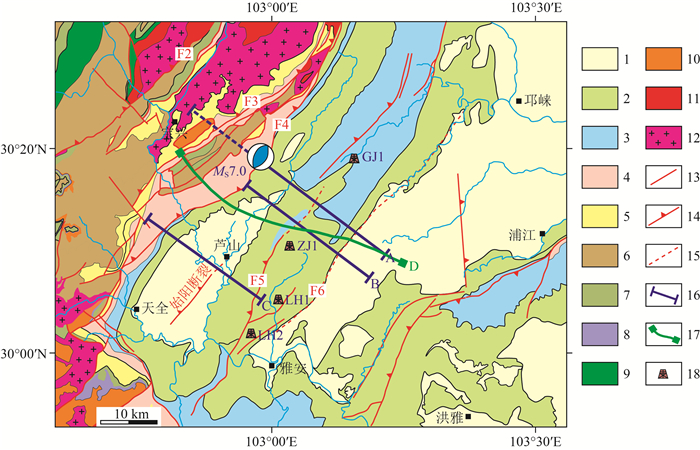
|
图 2 龙门山南段芦山震区区域地质构造简图(1971—1975年,1:200 000地质图;四川省地质局第二区域地质测量队三分队实测) 1—新生界;2—白垩系;3—侏罗系;4—三叠系;5—二叠系;6—泥盆系;7—志留系;8—奥陶系;9—寒武系;10—震旦系;11—元古界;12—杂岩体;13—主要断层;14—逆冲断层;15—隐伏断层;16—人工地震反射剖面;17—深地震反射剖面;18—钻井位置. Fig. 2 Geology and location of artificial seismic reflection profiles in research area 1— Cenozoic; 2— Cretaceous; 3— Jurassic; 4— Triassic; 5— Permian; 6— Devonian; 7— Silurian; 8— Ordovician; 9— Cambrian; 10— Sinian; 11— Proterozoic; 12— Complex rocks; 13— Major faults; 14—Thrusts; 15— Blind faults; 16— Artificial seismic reflection profile; 17— Deep seismic reflection profile; 18— Drilling wells. |
此外,大量研究表明川西—龙门山冲断带发育多层次的滑脱层(刘和甫等,1994;Liu et al., 1996;Lu et al., 2016).滑脱层通常是一种塑性特征明显的岩层, 这种塑性特征是指上下不同岩层能干性上的差异, 具有“相对性”意义;所以在具体的岩石地层中,夹于能干性岩层之间的非能干性岩层在构造变形中就可以成为滑脱层(汤良杰等,2008).
本次研究根据川西—龙门山南段区域岩石岩性特征,并结合之前研究成果(金文正等,2008;鲁人齐等,2010;Li et al., 2014b),分析了自前震旦纪基底而上可能存在的滑脱层系(图 3).其中川西—龙门山地区最主要的区域滑脱层,是中下三叠统嘉陵江—雷口坡组的膏岩层(D1).该滑脱层在钻井取芯和地震反射剖面中均有揭示,并可以和川东地区的巨厚膏岩滑脱层相对比(Jia et al., 2006;Lu et al., 2016).在龙门山南段前的川西凹陷地区前震旦纪基底也存在局部韧性剪切滑脱层(D2) 或拆离层(汤良杰等,2008;王绪本等,2008;颜丹平等,2010).此外,深部地球物理研究结果表明,在龙门山中、南段上地壳约17~20 km存在明显的低阻低速体为一深层滑脱层(Wang et al., 2007;Li et al., 2009;Hubbard and Shaw, 2009;Li et al., 2014a).这些滑脱层调节了龙门山上地壳的构造变形,对龙门山的形成演化具有重要的作用.

|
图 3 川西—龙门山南段地区岩石地层综合柱状图 Fig. 3 Stratigraphic chart of Longmen Shan and western Sichuan Basin |
在2013年芦山MW6.7地震发生之前,该龙门山南段的芦山地区部署和采集了大量石油工业地震反射剖面以及一些油气钻井,其中一条人工地震反射剖面A刚好位于震中附近,但北西方向并未穿过震中区域(图 1,图 2,图 4).
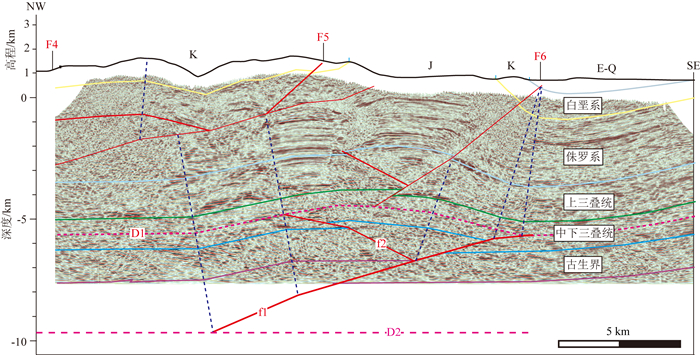
|
图 4 龙门山南段芦山震区A地震反射剖面地质构造解释 Fig. 4 Geological and structural interpretation of the seismic reflection profile A |
人工地震A剖面反射特征表现了三种类型:断层F5的NW侧地震记录地表至约5 km深度范围为没有明显反射的“透明”介质,这类记录反映的是介质整体性好;F5的SE侧岩性反射凌乱呈“破碎”结构特征;断层F6的SE侧反射区间显示了较好的成层结构.不同的反射记录特征很好地显示了剖面的横向非均匀构造(图 4).
芦山地区沉积了较厚的中生代和新生代地层(图 4).浅层构造受控于深度约5~6 km的中、下三叠统雷口坡—嘉陵江组的石膏岩滑脱层D1(鲁人齐等,2010).该浅层滑脱层D1之上,发育浅层逆冲断层形成叠瓦构造,如新开店断裂(F5)、山前的大邑隐伏断裂(F6).在地震反射剖面A同时可以发现新开店断裂下盘,发育一个大型的背斜,浅层滑脱层D1发生明显的构造变形.地震解释在基底深度大约10 km也存在滑脱层D2(颜丹平等,2008).基底断层根据岩层形变和轴面分析(Shaw et al., 2004),推测发育在滑脱层D2之上.如断层f1(图 4),断层转折并交汇于浅层滑脱层D1,形成断层转折褶皱(Suppe, 1983).褶皱内部发育反冲断层,如断层f2.
3.2 人工地震反射B剖面解释人工地震反射剖面B比较清楚地显示芦山向斜构造(图 2,图 5).芦山向斜白垩系的地震反射波组总体连续,未见断层切割该套地层.剖面B的总体构造变形特征与剖面A相似(图 4),浅层滑脱层D1之上发育叠瓦构造;滑脱层D1和D2之间为断层转折褶皱变形.
3.3 人工地震反射C剖面解释人工地震反射剖面C横跨芦山向斜(图 2,图 5).地震反射波组特征显示,始阳断裂切割了白垩系;地质图显示该断层还突破了新生界,在地表出露(图 2);地震解释认为该断裂向下发育在深度约2~3 km左右的更浅层的滑脱层(推测为上侏罗统遂宁组)之上(图 3,图 6).在双石—大川断裂(F4) 下盘浅层滑脱层D1之上,并未见到任何断层切割.之前的人工地震解释F4的总体产状小于50°(王夫运等,2015;冯杨洋等,2016).在中生界三叠系也存在早期的逆断层和褶皱变形.这些逆断层规模不大并未突破侏罗系,下侏罗统可能卷入变形,龙门山南段存在下侏罗统与中侏罗统的平行不整合面(刘树根等,2009),因此该期构造事件可能持续到早侏罗世.但总体变形主要与晚三叠世末期龙门山地区的构造事件有关(Liu et al., 1996;Jia et al., 2006).

|
图 5 龙门山南段芦山震区B地震反射剖面地质构造解释 Fig. 5 Geological and structural interpretation of the seismic reflection profile B |
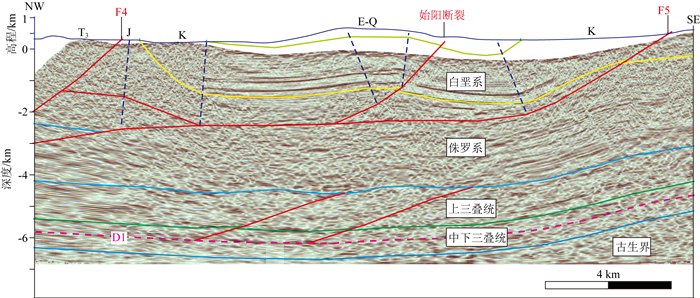
|
图 6 龙门山南段芦山震区C地震反射剖面地质构造解释 Fig. 6 Geological and structural interpretation of the seismic reflection profile C |
由于上述石油地震反射剖面的探测深度有限(图 3-6),不能有效揭示前震旦纪基底以下的构造变形.因此对2013年芦山地震的发震构造及其属性探讨还需要更多深部探测资料进一步约束.汶川地震和芦山地震相继发生后,科研人员在龙门山地区开展了地震宽角反射、折射探测工作,以揭示震区速度结构和地壳结构(嘉世旭等,2014;王帅军等,2015).其中,中国地质科学院地质研究所在芦山地区部署采集的反射地震剖面(冯杨洋等,2016),以及中国地震局地球物理勘探中心在震区采集了一条人工深地震反射剖面(王夫运等,2015),为研究芦山震区深部结构提供了丰富的信息(图 7).

|
图 7 芦山震区深地震反射剖面及发震构造解释(据王夫运等(2015)修改) Fig. 7 Deep seismic reflection profile and seismogenic structure of the Lushan earthquake (modified from Wang et al., 2015) |
芦山地震震源深度约14 km,震源机制解揭示断层信息为走向209°,倾角46°,滑动角94°(吕坚等,2013).通过对该深地震剖面的层位对比和标定,结合主震和小震重定位结果(房立华等,2013), 在深地震反射剖面附近约5 km范围截取余震投影.研究发现芦山主震和余震上方存在明显的地震波组断错(图 7),地震解释认为这是存在基底断层最直接的证据.该断层切割了下古生界和部分上古生界,但并未突破中生界,因此分析为早于三叠纪的断层.此外,从主断层上盘的沉积厚度变化可以看出,该断层控制了古生界的沉积;上盘的沉积厚度大于下盘的沉积厚度,因此为一早期正断层.因为该断层与芦山主震及其余震重定位结果高度吻合(图 7),因此鉴定为芦山地震的发震断层.
前人的研究认为,沿龙门山西缘存在早期同沉积正断裂,并控制了南北两段古生界至中三叠世的沉积(刘树根,1993;陈竹新等,2005).先前龙门山南段的地震解释结果,也证实了早期正断层的存在(Jia et al., 2006).因此,芦山地震的发震断层与龙门山主要断裂的形成演化具有一致性.这些断裂先后经历了伸展裂陷阶段、构造反转和持续推覆阶段(陈社发等,1994);在晚新生代以来,部分早期存在的断层在强烈持续挤压下重新活化,并产生地震.
4.2 同震断层与发震构造模型通过对芦山震区浅层人工地震反射剖面的解释,认为芦山地震的发震断层并未突破中生界和新生界(图 4-7),是一条典型的盲断层,这与最新深地震探测解释(冯杨洋等,2016),以及野外地质调查结果(李传友等,2013;雷生学等,2014)是一致的.此外,芦山地震同震形变资料,包括水准和GPS观测数据显示(Jiang et al., 2014;郝明等,2014),在芦山向斜位置存在最大同震形变位移,可能与断层传播褶皱模型(Fault-Propagation Fold)相匹配(Suppe and Medwedeff, 1990;徐锡伟等,2013).但单次地震活动产生的同震形变,并不能有效约束地震构造模型.芦山主震南东方向的背斜构造为一活动构造(Wang et al., 2014),该构造的主断层f1切割中生界的累积位移量约2~3 km(图 3,图 4),构造变形量相对较大(图 8).主要发震构造几何特征表现为前翼陡窄、后翼宽缓.因此,简单剪切断层转折褶皱模型更符合芦山地震长周期的地质构造变形(Shaw et al., 2004).2013年的芦山地震的同震断层与主要发震构造有所区别,为一次非特征型地震.
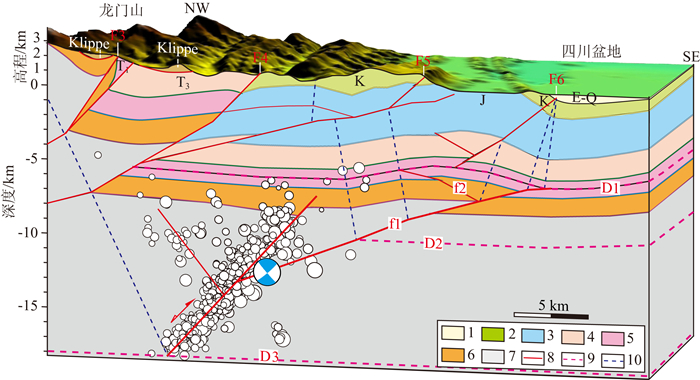
|
图 8 龙门山南段芦山震区三维地质构造模型与发震构造分析 1—新生界;2—白垩系;3—侏罗系;4—上三叠统;5—中下三叠统;6—上古生界;7—下古生界与基底;8—主要断层;9—主要滑脱层;10—轴面. Fig. 8 Three-dimensional geological and structural model and seismotectonics of the Lushan earthquake 1— Cenozoic; 2— Cretaceous; 3— Jurassic; 4— Upper Triassic; 5— Middle-Lower Triassic; 6— Upper Paleozoic; 7— Pre-Cambrian and basement; 8— Major faults; 9— Main detachments; 10— Axial surfaces. |
通过对地震反射剖面C的综合解释,揭示了龙门山南段浅层沉积和构造变形特征(图 8).龙门山南段—川西盆地总体构造变形,受控于浅层滑脱层(D1)、中部基底滑脱层(D2) 以及深部滑脱层(D3) 的控制.浅层滑脱层D1控制了现今龙门山前的浅层逆冲断层系统和构造地貌;中部滑脱层D2之上发育断层相关褶皱;深部滑脱层D3之上存在早期正断层,后期构造反转形成逆断层,并在后期重新活化.汶川地震、芦山地震是龙门山地区晚新生代以来不同断层逆冲活动、发展和演化的体现.因此,龙门山冲断带—川西前陆盆地总体构造变形呈现出一个多层滑脱、多期变形、构造叠加的复杂特点,这无疑增加了构造研究的难度,同时也是造成2013年芦山地震后存在大量不同认识的重要原因之一.
5 结论(1) 2013年龙门山南段芦山地震的主要发震断层倾角大约在45°~50°,并未突破中生界和新生界,为一典型盲冲断层;总体的地震构造特征符合简单剪切断层转折褶皱模型.
(2) 芦山地震的发震断层为一早期(古生代)正断层.晚新生代在青藏高原向四川盆地的强烈挤压作用下,芦山震区构造开始反转后活化,并产生了非特征地震.
(3) 龙门山南段主要发育多套不同层次的滑脱层,控制了上地壳总体的变形,呈现出多层滑脱、多期变形、构造叠加的复杂特点.
致谢感谢美国休斯敦大学地球与大气科学学院John Suppe教授和中国地震局地质研究所邓起东研究员的交流指导与宝贵建议!感谢两位匿名评审专家提供大量宝贵的参考建议和修改意见!感谢中国石油西南公司提供的人工地震反射剖面和钻井资料;感谢河北省地震局王晓山在小震精定位成图上的帮助!
| Burchfiel B C, Chen Z L, Liu Y P, et al. 1995. Tectonics of the Longmen Shan and adjacent regions, central China. International Geology Review, 37(8): 661-735. DOI:10.1080/00206819509465424 | |
| Chen L C, Wang H, Ran Y K, et al. 2014. Lushan MS7.0 Earthquake, varied seismogenic structure from the 2008 Wenchuan earthquake. Seismological Research Letters, 85(1): 34-39. DOI:10.1785/0220130109 | |
| Chen S F, Deng Q D, Zhao X Z, et al. 1994. The evolution and deformation mechanism of the related structures of the middle section of the Longmen Shan thrust belt. Seismology and Geology, 16(4): 404-412. | |
| Chen S F, Wilson C J L. 1996. Emplacement of the Longmen Shan thrust-nappe belt along the eastern margin of the Tibetan Plateau. Journal of Structure Geology, 18(4): 413-430. | |
| Chen Z X, Jia D, Zhang Q, et al. 2005. Balanced cross-section analysis of the fold-thrust belt of the Longmen Mountains. Acta Geologica Sinica, 79(1): 38-45. | |
| Deng Q D, Zhang P Z, Ran Y K, et al. 2003. Basic characteristics of active tectonics of China. Science in China Series D :Earth Sciences, 46(4): 356-418. | |
| Feng Y Y, Yu C Q, Fan Z G, et al. 2016. Fine crustal structure of the Lushan area derived from seismic reflection profiling. Chinese Journal of Geophysics, 59(9): 3248-3259. DOI:10.6038/cjg20160910 | |
| Fang L H, Wu J P, Wang W L, et al. 2013. Relocation of the mainshock and aftershock sequences of MS7.0 Sichuan Lushan earthquake. Chinese Science Bulletin, 58(28-29): 3451-3459. DOI:10.1007/s11434-013-6000-2 | |
| Han L B, Zeng X F, Jiang C S, et al. 2014. MW6.6 Lushan, China earthquake and high-resolution aftershock relocations. Seismological Research Letters, 85(1): 8-14. DOI:10.1785/0220130083 | |
| Hao M, Wang Q L, Liu L W, et al. 2014. Interseismic and coseismic displacements of the Lushan MS7.0 earthquake inferred from leveling measurements. Chinese Science Bulletin, 59(35): 5129-5135. DOI:10.1007/s11434-014-0652-4 | |
| Hubbard J, Shaw J H. 2009. Uplift of the Longmen Shan and Tibetan Plateau, and the 2008 Wenchuan (M=7. 9) earthquake. Nature, 458(7235): 194-197. DOI:10.1038/nature07837 | |
| Jia D, Chen Z X, Jia C Z, et al. 2003. Structural features of the Longmen Shan fold and thrust belt and development of the western Sichuan Foreland Basin, central China. Geological Journal of China Universities, 9(3): 402-410. | |
| Jia D, Wei G Q, Chen Z X, et al. 2006. Longmen Shan fold-thrust belt and its relation to the western Sichuan Basin in central China: new insights from hydrocarbon exploration. AAPG Bulletin, 90(9): 1425-1447. DOI:10.1306/03230605076 | |
| Jia S X, Liu B J, Xu Z F, et al. 2014. The crustal structures of the central Longmenshan along and its margins as related to the seismotectonics of the 2008 Wenchuan Earthquake. Science China Earth Sciences, 57(4): 777-790. DOI:10.1007/s11430-013-4744-9 | |
| Jiang Z S, Wang M, Wang Y Z, et al. 2014. GPS constrained coseismic source and slip distribution of the 2013 MW6.6 Lushan, China, earthquake and its tectonic implications. Geophysical Research Letters, 41(2): 407-413. DOI:10.1002/2013GL058812 | |
| Jin W Z, Tang L J, Yang K M, et al. 2008. Progress and problem of study on characters of the Longmen Mountain thrust belt. Geological Review, 54(1): 37-46. | |
| Lü J, Wang X S, Su J R, et al. 2013. Hypocentral location and source mechanism of the MS7.0 Lushan earthquake sequence. Chinese Journal of Geophysics, 56(5): 1753-1763. DOI:10.6038/cjg20130533 | |
| Lei S X, Ran Y K, Wang H, et al. 2014. Discussion on whether there are coseismic surface ruptures of the Lushan MS7.0 earthquake at Longmen area and its implications. Seismology and Geology, 36(1): 266-274. | |
| Li C Y, Xu X W, Gan W J, et al. 2013. Seismogenic structures associated with the 20 April 2013 MS7.0 Lushan earthquake, Sichuan Province. Seismology and Geology, 35(3): 671-683. | |
| Li H B, Fu X F, Van Der Woerd J, et al. 2008. Co-seismic surface rupture and dextral-slip oblique thrusting of the MS8.0 Wenchuan Earthquake. Acta Geologica Sinica, 82(12): 1623-1643. | |
| Li H Y, Su W, Wang C Y, et al. 2009. Ambient noise Rayleigh wave tomography in western Sichuan and eastern Tibet. Earth and Planet Science Letters, 282(1-4): 201-211. DOI:10.1016/j.epsl.2009.03.021 | |
| Li Y, Zhou R J, Dong S L, et al. 2008. Surface rupture, thrusting and strike-slipping in the Wenchuan earthquake of Sichuan, China. Journal of Chengdu University of Technology (Science and Technology Edition), 35(4): 404-413. | |
| Li Y, Zhou R J, Zhao G H, et al. 2013. Thrusting and detachment folding of Lushan earthquake in front of Longmenshan Mountains. Journal of Chengdu University of Technology (Science and Technology Edition), 40(4): 353-363. | |
| Li Y Q, Jia D, Wang M M, et al. 2014a. Structural geometry of the source region for the 2013 MW6.6 Lushan earthquake, implication for earthquake hazard assessment along the Longmen Shan. Earth and Planetary Science Letters, 390: 275-286. DOI:10.1016/j.epsl.2014.01.018 | |
| Li Z G, Jia D, Chen W, et al. 2014b. Late Cenozoic east-west crustal shortening in southern Longmen Shan eastern Tibet: Implications for regional stress field changes. Tectonophysics, 623: 169-186. DOI:10.1016/j.tecto.2014.03.033 | |
| Liu H P, Liang H S, Cai G L, et al. 1994. Structural styles of the Longmenshan thrust belt and evolution of the foreland basin in western Sichuan province, China. Acta Geological Sinica, 68(2): 101-118. | |
| Liu S, Zhang S M, Ding R, et al. 2015. Upper crustal folding of the 2013 Lushan earthquake area in southern Longmen Shan, China, insights from Late Quaternary fluvial terraces. Tectonophysics, 639: 99-108. DOI:10.1016/j.tecto.2014.11.016 | |
| Liu S G. 1993. The Formation and Evolution of Longmenshan Thrust Zone and Western Sichuan. Chengdu: Press of Chengdu University of Science and Technology. | |
| Liu S G, Li Z W, Cao J X, et al. 2009. 4-D textural and structural characteristics of Longmen intracontinental composite orogenic belt, southwest China. Chinese Journal of Geology, 44(4): 1151-1180. | |
| Liu S G, Luo Z L, Dai S L, et al. 1996. The uplift of the Longmenshan thrust belt and subsidence of the west Sichuan foreland basin. Acta Geological Sinica, 9(1): 16-26. | |
| Lu R Q, He D F, Suppe J, et al. 2010. The structures, formation and evolution of the shallow thrusting system in the central Longmen mountains front belt. Chinese Journal of Geology, 45(4): 997-1010. | |
| Lu R Q, He D F, Xu X W, et al. 2016. The basement structures beneath the Central segment of Longmen Shan: Constraints on the uplifting in the southeast margin of Qinghai-Tibet Plateau since the Cenozoic. Journal of Asian Earth Sciences, 117: 73-81. DOI:10.1016/j.jseaes.2015.11.019 | |
| Luo Z L. 1991. The dynamical model of the lithospheric evolution in Longmenshan orogenic belt. Journal of Chengdu Institute of Technology, 18(1): 1-7. | |
| Ma Y S, Long C X, Tan C X, et al. 2008. Co-seismic deformation features and segmentation of the MS8.0 Wenchuan earthquake in Sichuan, China. Geological Bulletin of China, 27(12): 2076-2085. | |
| Shaw J H, Connors C, Suppe J. 2004. Seismic Interpretation of Contractional Fault-Related Folds: An AAPG Seismic Atlas. Tulsa: American Association of Petroleum Geologists, 1-156. https://www.researchgate.net/publication/264739641_Seismic_interpretation_of_contractional_fault-related_folds | |
| Suppe J. 1983. Geometry and kinematics of fault-bend folding. American Journal of Science, 283(7): 684-721. DOI:10.2475/ajs.283.7.684 | |
| Suppe J, Medwedeff D A. 1990. Geometry and kinematics of fault propagation folding. Eclogae Geologicae Helvetiae, 83(3): 409-454. | |
| Tang L J, Yang K M, Jin W Z, et al. 2008. Multi-level decollement zones and detachment deformation of Longmenshan thrust belt, Sichuan Basin, southwest China. Science in China Series D: Earth Sciences, 51(S2): 32-43. DOI:10.1007/s11430-008-6014-9 | |
| Tapponnier P, Xu Z Q, Roger F, et al. 2001. Oblique stepwise rise and growth of the Tibet Plateau. Science, 294(5547): 1671-1677. DOI:10.1126/science.105978 | |
| Wang C Y, Han W B, Wu J P, et al. 2007. Crustal structure beneath the eastern margin of the Tibetan Plateau and its tectonic implications. Journal of Geophysical Research: Solid Earth, 112(B7): B07307. DOI:10.1029/2005JB003873 | |
| Wang F Y, Zhao C B, Feng S Y, et al. 2015. Seismogenic structure of the 2013 Lushan MS7.0 earthquake revealed by a deep seismic reflection profile. Chinese Journal of Geophysics, 58(9): 3183-3192. DOI:10.6038/cjg20150914 | |
| Wang M, Jia D, Shaw J H, et al. 2014. The 2013 Lushan earthquake, implications for seismic hazards posed by the range front blind thrust in the Sichuan Basin, China. Geology, 42(10): 915-918. DOI:10.1130/G35809.1 | |
| Wang S J, Wang F Y, Zhang J S, et al. 2015. The deep seismogenic environment of Lushan MS7.0 earthquake zone revealed by a wide-angle reflection/refraction seismic profile. Chinese Journal of Geophysics, 58(9): 3193-3204. DOI:10.6038/cjg20150915 | |
| Wang X B, Yu N, Zhu Y T, et al. 2008. Preliminary result of magnetotelluric sounding in the Longmen thrust belt of West Sichuan, China. Journal of Chengdu University of Technology (Science & Technology Edition), 35(4): 398-403. | |
| Xu X W, Wen X Z, Han Z, et al. 2013. Lushan MS7.0 earthquake: a blind reserve-fault event. Chinese Science Bulletin, 58(28-29): 3437-3443. DOI:10.1007/s11434-013-5999-4 | |
| Xu X W, Wen X Z, Ye J Q, et al. 2008. MS8.0 Wenchuan earthquake surface ruptures and its seismogenic structure. Seismology and Geology, 30(3): 597-629. | |
| Xu Z Q, Hou Q W, Wang Z X. 1992. Orogenic Processes of the Songpan Garzê Orogenic Belt of China. Beijing: Geological Publishing House: 1-90. | |
| Yan D P, Li S B, Cao W T, et al. 2010. Multi-layer detachment crustal structure in the Longmen mountains: evidences from neo-tectonic deformation and geophysical data. Earth Science Frontiers, 17(5): 106-116. | |
| Zeng X F, Luo Y, Han L B, et al. 2013. Lushan MS7.0 earthquake on 20 April 2013: A high-angle thrust event. Chinese Journal of Geophysics, 56(4): 1418-1424. DOI:10.6038/cjg20130437 | |
| Zhang H P, Yi G X, Zhang P Z, et al. 2015. On the evolution of seismogenic faults in the Longmen Shan, eastern Tibet. Journal of Asian Earth Sciences, 111: 624-631. DOI:10.1016/j.jseaes.2015.05.014 | |
| Zhang Y Q, Dong S W, Hou C T, et al. 2013. Seismogenic structure of the April 20, 2013, Lushan MS7 earthquake in Sichuan. Acta Geologica Sinica (English Edition), 87(3): 633-645. DOI:10.1111/acgs.2013.87.issue-3 | |
| Zhou R J, Li Y, Su J T, et al. 2013. Seismogenic structure of Lushan MW6.6 earthquake, Sichuan, China. Journal of Chengdu University of Technology (Science & Technology Edition), 40(4): 364-370. | |
| 陈社发, 邓起东, 赵小麟, 等. 1994. 龙门山中段推覆构造带及相关构造的演化历史和变形机制(一). 地震地质, 16(4): 404–412. | |
| 陈竹新, 贾东, 张惬, 等. 2005. 龙门山前陆褶皱冲断带的平衡剖面分析. 地质学报, 79(1): 38–45. | |
| 邓起东, 张培震, 冉勇康, 等. 2002. 中国活动构造基本特征. 中国科学:地球科学, 32(12): 1020–1030, 1057. | |
| 冯杨洋, 于常青, 范柱国, 等. 2016. 从反射地震剖面中认识芦山地区的地壳精细结构和构造. 地球物理学报, 58(9): 3248–3259. DOI:10.6038/cjg20160910 | |
| 房立华, 吴建平, 王未来, 等. 2013. 四川芦山MS7.0级地震及其余震序列重定位. 科学通报, 58(20): 1901–1909. | |
| 郝明, 王庆良, 刘立炜, 等. 2014. 基于水准数据的芦山7.0级地震震间期和同震位移场特征. 科学通报, 59(36): 3631–3636. | |
| 贾东, 陈竹新, 贾承造, 等. 2003. 龙门山前陆褶皱冲断带构造解析与川西前陆盆地的发育. 高校地质学报, 9(3): 402–410. | |
| 嘉世旭, 刘保金, 徐朝繁, 等. 2014. 龙门山中段及两侧地壳结构与汶川地震构造. 中国科学:地球科学, 44(3): 497–509. | |
| 金文正, 汤良杰, 杨克明, 等. 2008. 龙门山冲断带构造特征研究主要进展及存在问题探讨. 地质论评, 54(1): 37–46. | |
| 吕坚, 王晓山, 苏金蓉, 等. 2013. 芦山7.0级地震序列的震源位置与震源机制解特征. 地球物理学报, 56(5): 1753–1763. DOI:10.6038/cjg20130533 | |
| 雷生学, 冉勇康, 王虎, 等. 2014. 关于芦山7.0级地震在龙门一带是否存在同震地表破裂的讨论. 地震地质, 36(1): 266–274. | |
| 李传友, 徐锡伟, 甘卫军, 等. 2013. 四川省芦山MS7.0地震发震构造分析. 地震地质, 35(3): 671–683. | |
| 李海兵, 付小方, Van Der WoerdJ, 等. 2008. 汶川地震(MS8.0) 地表破裂及其同震右旋斜向逆冲作用. 地质学报, 82(12): 1623–1643. DOI:10.3321/j.issn:0001-5717.2008.12.002 | |
| 李勇, 周荣军, 董顺利, 等. 2008. 汶川特大地震的地表破裂与逆冲-走滑作用. 成都理工大学学报(自然科学版), 35(4): 404–413. | |
| 李勇, 周荣军, 赵国华, 等. 2013. 龙门山前缘的芦山地震与逆冲-滑脱褶皱作用. 成都理工大学学报(自然科学版), 40(4): 353–363. | |
| 刘和甫, 粱慧社, 蔡立国, 等. 1994. 川西龙门山冲断系构造样式与前陆盆地演化. 地质学报, 68(2): 101–118. | |
| 刘树根. 1993. 龙门山冲断带与川西前陆盆地的形成演化. 成都: 成都科技大学出版社. | |
| 刘树根, 李智武, 曹俊兴, 等. 2009. 龙门山陆内复合造山带的四维结构构造特征. 地质科学, 44(4): 1151–1180. | |
| 鲁人齐, 何登发, SuppeJ, 等. 2010. 龙门山中段山前带浅层冲断系统的结构形成与演化. 地质科学, 45(4): 997–1010. | |
| 罗志立. 1989. 峨眉地裂运动的厘定及其意义. 四川地质学报, 9(1): 1–17. | |
| 罗志立. 1991. 龙门山造山带岩石圈演化的动力学模式. 成都地质学院学报, 18(1): 1–7. | |
| 马寅生, 龙长兴, 谭成轩, 等. 2008. 四川汶川MS8.0级地震同震变形特征和分段性. 地质通报, 27(12): 2076–2085. DOI:10.3969/j.issn.1671-2552.2008.12.013 | |
| 汤良杰, 杨克明, 金文正, 等. 2008. 龙门山冲断带多层次滑脱带与滑脱构造变形. 中国科学D辑:地球科学, 38(S1): 30–40. | |
| 王夫运, 赵成彬, 酆少英, 等. 2015. 深反射剖面揭示的芦山7.0级地震发震构造. 地球物理学报, 58(9): 3183–3192. DOI:10.6038/cjg20150914 | |
| 王帅军, 王夫运, 张建狮, 等. 2015. 利用宽角反射/折射地震剖面揭示芦山MS7.0地震震区深部孕震环境. 地球物理学报, 58(9): 3193–3204. DOI:10.6038/cjg20150915 | |
| 王绪本, 余年, 朱迎堂, 等. 2008. 龙门山逆冲构造带大地电磁测深初步成果. 成都理工大学学报(自然科学版), 35(4): 398–403. | |
| 徐锡伟, 闻学泽, 韩竹军, 等. 2013. 四川芦山7.0级强震一次典型的盲逆断层型地震. 科学通报, 58(20): 1887–1893. | |
| 许志琴, 侯立玮, 王宗秀. 1992. 中国松潘—甘孜造山带的造山过程. 北京: 地质出版社. | |
| 颜丹平, 李书兵, 曹文涛, 等. 2010. 龙门山多层分层拆离地壳结构:新构造变形与深部构造证据. 地学前缘, 17(5): 106–116. | |
| 徐锡伟, 闻学泽, 叶建青, 等. 2008. 汶川MS8.0地震地表破裂带及其发震构造. 地震地质, 30(3): 597–629. | |
| 曾祥方, 罗艳, 韩立波, 等. 2013. 2013年4月20日四川芦山MS7.0地震:一个高角度逆冲地震. 地球物理学报, 56(4): 1418–1424. DOI:10.6038/cjg20130437 | |
| 周荣军, 李勇, 苏金荣, 等. 2013. 四川芦山MW6.6级地震发震构造. 成都理工大学学报(自然科学版), 40(4): 364–370. | |
 2017, Vol. 60
2017, Vol. 60

